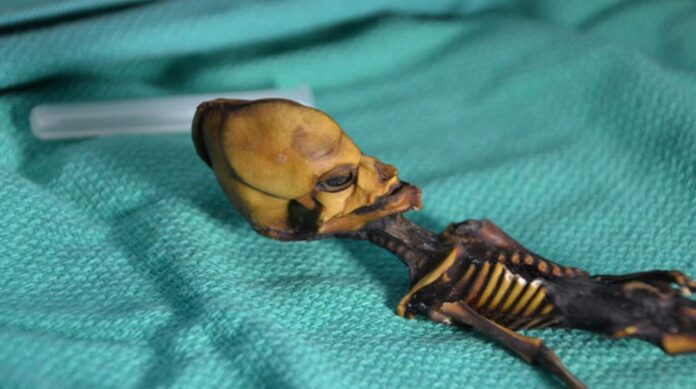The Atacama Skeleton, often referred to as “Ata,” is a tiny, unusual skeleton found in the Atacama Desert of Chile. Its strange appearance has puzzled scientists and sparked many theories about its origin.
In 2003, a man named Oscar Muñoz discovered the skeleton in a deserted town called La Noria in the Atacama Desert. The skeleton was wrapped in a white cloth and tied with a purple ribbon. At first glance, it seemed to be a mummified human fetus, but its unusual features suggested otherwise.
Unique Features
Ata is only about 6 inches (15 centimeters) long, with a cone-shaped skull, large eye sockets, and only 10 ribs instead of the usual 12 found in humans. These unique characteristics led to various speculations about its origin, including the possibility of it being an extraterrestrial being.
Scientific Studies
Several scientific studies have been conducted to determine the origin of the Atacama Skeleton. In 2013, DNA analysis revealed that Ata is human. The skeleton belonged to a female and showed signs of several genetic mutations. These mutations affected the skeletal development, leading to the unusual features.
Age of the Skeleton
Further studies have shown that Ata is likely a stillborn or prematurely born infant, who lived about 40 years ago. The age of the bones and the DNA indicated that the skeleton was not ancient but relatively modern.
Genetic Mutations
Researchers identified mutations in Ata’s genes that are responsible for bone development. These mutations likely caused the skeletal abnormalities seen in Ata, such as the unusual shape of the skull and the reduced number of ribs. These findings provided insights into rare bone diseases and developmental disorders.
Controversies and Speculations
Despite scientific evidence, many people still believe that the Atacama Skeleton has extraterrestrial origins. The combination of Ata’s small size, unusual features, and the mystery surrounding its discovery has fueled these speculations. However, the scientific community widely accepts the human origin of the skeleton.
The Atacama Skeleton has captured the public’s imagination and has been featured in documentaries, books, and online discussions. It highlights the fascination with the unknown and the eagerness to explore the mysteries of our world.
Interesting Facts About the Atacama Skeleton
- Ata was found in the Atacama Desert, one of the driest places on Earth.
- The skeleton measures only 6 inches (15 centimeters) in length.
- Ata has a cone-shaped skull and large eye sockets.
- The skeleton has only 10 ribs, while a typical human has 12.
- DNA analysis confirmed that Ata is human.
- The skeleton belonged to a female.
- Genetic mutations caused Ata’s unusual skeletal features.
- Ata is believed to have lived about 40 years ago.
- The skeleton’s discovery location, La Noria, is a deserted town.
- Ata’s unique features sparked theories of extraterrestrial origin.
- The Atacama Desert’s dry conditions helped preserve the skeleton.
- Ata was wrapped in a white cloth when discovered.
- The skeleton’s DNA showed similarities to modern humans.
- The genetic mutations found in Ata are rare and affect bone development.
- The scientific community widely accepts Ata’s human origin.
- Ata has been featured in documentaries and books.
- The skeleton has sparked interest in rare genetic disorders.
- Ata’s discovery location, La Noria, is considered a ghost town.
- The Atacama Desert is known for its archaeological finds.
- Ata’s unusual features led to initial speculations of it being a hoax.
- The skeleton’s small size is due to genetic mutations affecting growth.
- Ata’s DNA analysis was conducted by researchers from Stanford University.
- The skeleton provides insights into rare bone diseases.
- Ata’s preservation was aided by the dry desert climate.
- The Atacama Desert has extreme temperature variations.
- Ata’s discovery has contributed to the study of human developmental disorders.
- The skeleton’s genetic mutations are similar to those seen in severe dwarfism.
- Ata’s unusual appearance continues to intrigue people worldwide.
- The Atacama Desert is also known for its rich history and ancient civilizations.
- Ata remains one of the most fascinating and mysterious archaeological finds of the 21st century.
The Atacama Skeleton, with its tiny size and unusual features, continues to be a subject of fascination and study. While scientific evidence points to its human origin, the mystery and intrigue surrounding Ata ensure it remains a captivating topic for both researchers and the public.
